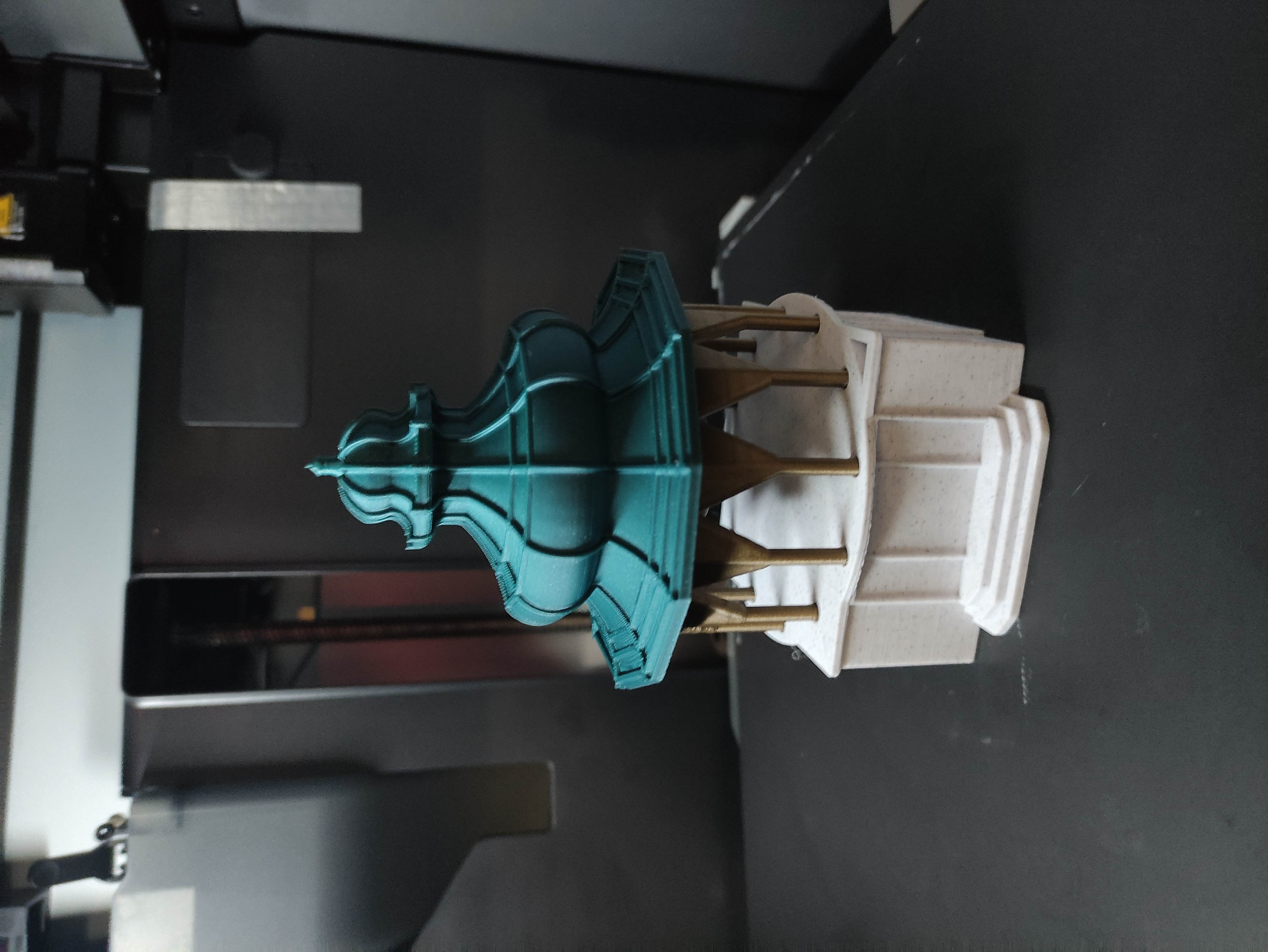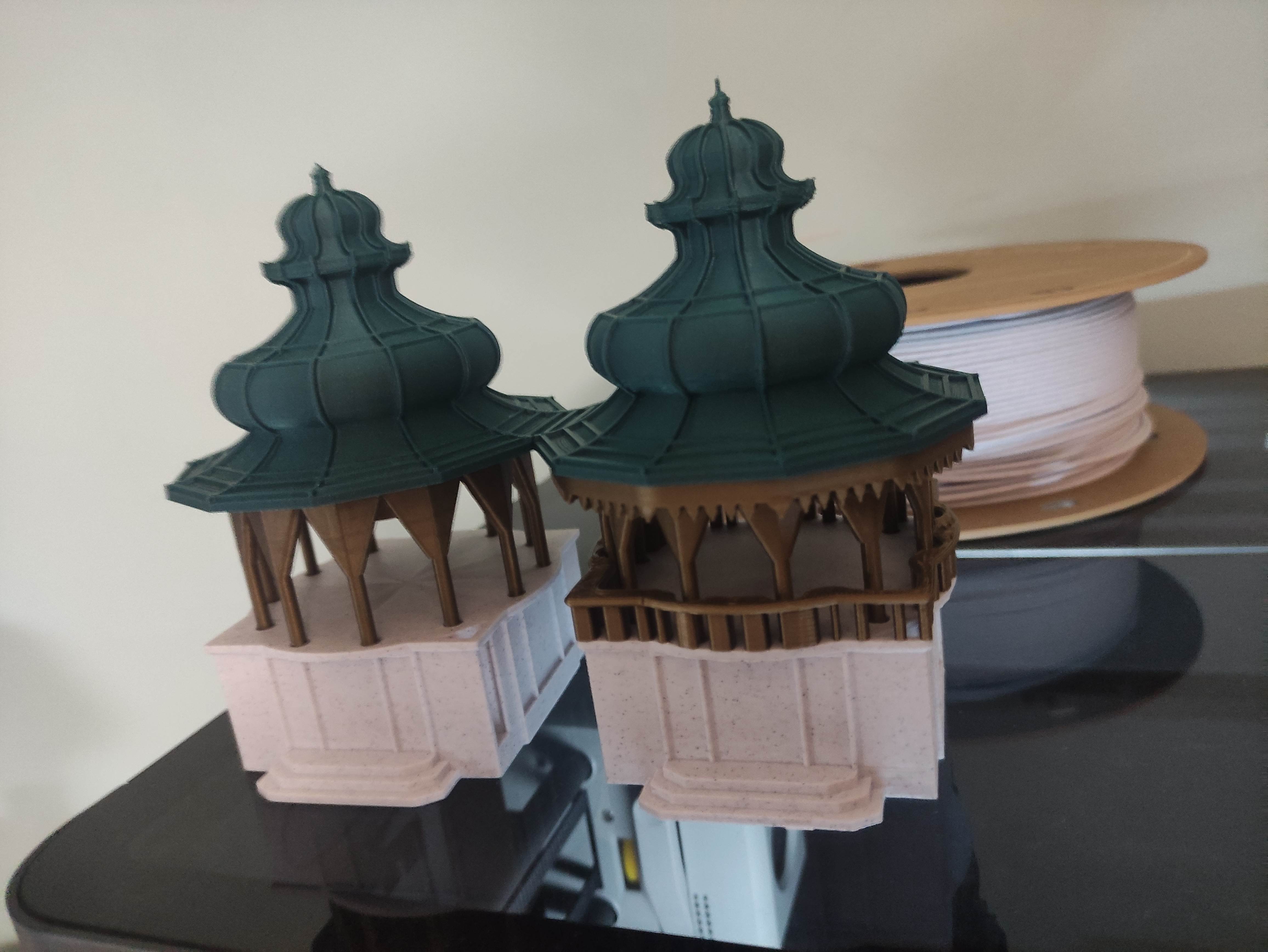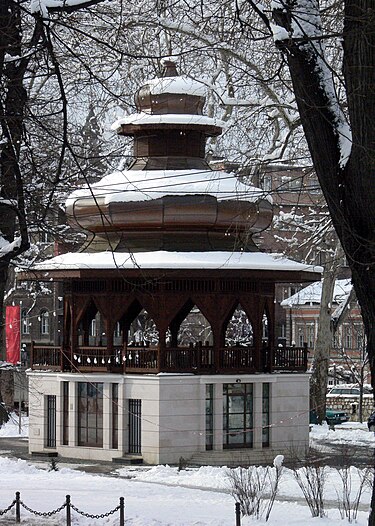- Dimension:9cm (W) × 9cm (D) × 12.5cm (H)
- Material:Made from eco-friendly, biodegradable plastice
- Design and production:Expertly designed for 12 hours, 3D printed in 7 hours
- Packing:
Eco-friendly and recyclable; return it and receive a discount on your next purchase
- Maintenance instructions:
Keep away from direct sunlight; handle with care, especially during transport
- Impact:
With every purchase, you help restock local rivers and lakes
- Interactive feature:
Scan the QR code and explore the rich history of Sarajevo
- Ecology:
Part of the funds from the purchase of this souvenir will be used for restocking lakes and rivers in Bosnia and Herzegovina
ABOUT THE BUILDING
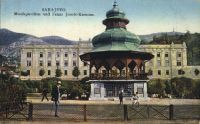
Sarajevo is the center of architectural gems from various historical periods and as such is one of the most attractive destinations for tourists. But one location in the heart of the Old Town with its beauty and harmony attracts not only tourists, but also local residents. Park At Mejdan is one of the most famous parks in the area of the capital of Bosnia and Herzegovina, and it covers as much as 2,500 square meters. With its position on the left bank of Miljacka, it is the perfect place for all those who want to feel a bit of peace and tranquility, yet be close to the city center and all events.
It is interesting that inside the park there is the only remaining music pavilion in Sarajevo and that it is also considered an archaeological site where the remains of a mosque, madrasah, harem, mekteb, paved paths and grave frames were found. And Mejdan, due to its rich history and numerous empires that ruled the territory of Bosnia and Herzegovina, is considered a place that has changed its purpose and purpose many times, and is therefore an ideal location if you want to walk through history and feel the influence of different cultures.
HISTORIJA
When Sarajevo was founded in the 15th century under Ottoman rule, the present-day park was then a place where punishments were carried out. For this reason, it was named Sijaset Mejdan, or in translation, the square for carrying out punishments. It was only at the end of the 15th century that this area began to be used for the purpose of horse trading, reaching its peak in the 17th century as a hippodrome. It is from this period that the name At Mejdan, which in Turkish means horse square, originates.
From the 16th to the 18th centuries, mosques, madrasas and harems were built on an area of 2,500 square meters, and by the mid-18th century, At Mejdan was a center of culture and education. In 1544, Hajji Alija Bakr-baba built a mosque that is first mentioned in historical records in 1565. With the arrival of the Austro-Hungarian Empire, this mosque changed its purpose to a military warehouse in 1878, and was demolished just seventeen years later.
On the eastern side of the mosque cemetery, Hajji Ismail Misrija built a madrasa back in 1741, which was reconstructed and upgraded several times in the period of almost 200 years of its existence. Under the rule of Austria-Hungary, this madrasa was demolished in 1939, and a preserved well was found next to the madrasa during excavation. Abdulah-efendija Kantamirija built a library not far from the madrasa in the 18th century, so in that period At Mejdan was a gathering center for students and professors.
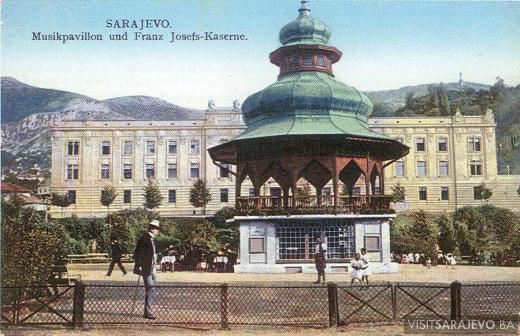 At the end of the 19th century, the Austro-Hungarians demolished everything that had been built in this area and changed At Mejdan's name to Filipović Square, after Baron Josip Filipović, who was the commander of the occupying forces in that period. Not long after the name change, they also built Filipović's barracks right above the square. The name of Filipović Square was changed in 1905, when the former square was merged with Vojni Square, to Trg Franje Josip Square after the Emperor of the Austro-Hungarian Monarchy.
At the end of the 19th century, the Austro-Hungarians demolished everything that had been built in this area and changed At Mejdan's name to Filipović Square, after Baron Josip Filipović, who was the commander of the occupying forces in that period. Not long after the name change, they also built Filipović's barracks right above the square. The name of Filipović Square was changed in 1905, when the former square was merged with Vojni Square, to Trg Franje Josip Square after the Emperor of the Austro-Hungarian Monarchy.
The Austro-Hungarians left one asset before the entry of Bosnia and Herzegovina into Yugoslavia, and that is the music pavilion that was built in 1913 according to the
designs of Josip Pospišil. During the time of the Kingdom of Serbs, Croats and Slovenes, that is, the Kingdom of Yugoslavia, between the two world wars, this area was named after Emperor Dušan, that is, the first Serbian emperor, and it was only in 1925 that it was declared a park. During the Second World War in 1941, the park was destroyed by bombing by Nazi Germany.
The name At Mejdan was returned only in 1993, and the park and pavilion were reconstructed in 2004. Inside the At Mejdan park, archaeologists excavated the remains of a demolished mosque, madrasa and cemetery, so in 2015 At Mejdan was declared a protected archaeological area.
BUILDING STYLE
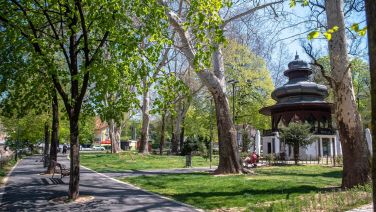 The remains of the mosque, madrasah, harem and mezarluk were built during the period when the Ottoman Empire ruled what is now Bosnia and Herzegovina. Ottoman architecture has its roots in Asia Minor, and was created under the influence of Islamic art and beliefs. When the Ottoman Empire occupied the Balkans, their architecture was not developed to its full potential, so the mosques and landmarks built in the 15th century took on the basic characteristics of the old Constantinople style. This period is often called the golden age of Ottoman architecture, due to the large number of contemporaries and buildings that were designed and built, but what is recognizable is that all the buildings lack a certain form. During this period, the right forms, shapes and colors for construction were still being sought. Unfortunately, within the protected area of At Mejdan, only the remains of the landmarks remain, so we cannot see this style of construction directly in the example.
The remains of the mosque, madrasah, harem and mezarluk were built during the period when the Ottoman Empire ruled what is now Bosnia and Herzegovina. Ottoman architecture has its roots in Asia Minor, and was created under the influence of Islamic art and beliefs. When the Ottoman Empire occupied the Balkans, their architecture was not developed to its full potential, so the mosques and landmarks built in the 15th century took on the basic characteristics of the old Constantinople style. This period is often called the golden age of Ottoman architecture, due to the large number of contemporaries and buildings that were designed and built, but what is recognizable is that all the buildings lack a certain form. During this period, the right forms, shapes and colors for construction were still being sought. Unfortunately, within the protected area of At Mejdan, only the remains of the landmarks remain, so we cannot see this style of construction directly in the example.
The remains of the mosque, madrasah, harem and mezarluk were built during the period when the Ottoman Empire ruled what is now Bosnia and Herzegovina. Ottoman architecture has its roots in Asia Minor, and was created under the influence of Islamic art and beliefs. When the Ottoman Empire occupied the Balkans, their architecture was not developed to its full potential, so the mosques and landmarks built in the 15th century took on the basic characteristics of the old Constantinople style. This period is often called the golden age of Ottoman architecture, due to the large number of contemporaries and buildings that were designed and built, but what is recognizable is that all the buildings lack a certain form. During this period, the right forms, shapes and colors for construction were still being sought. Unfortunately, within the protected area of At Mejdan, only the remains of the landmarks remain, so we cannot see this style of construction directly in the example.
MATERIALS FROM WHICH THE MUSIC PAVILION AT MEJDAN IS MADE
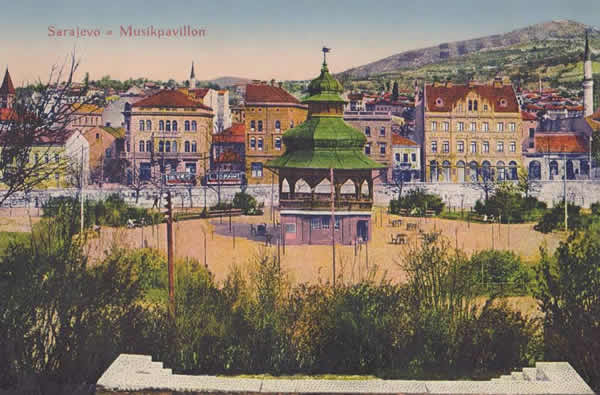 The At Mejdan Music Pavilion is built of three basic materials: concrete, wood, and sheet metal.
The At Mejdan Music Pavilion is built of three basic materials: concrete, wood, and sheet metal.The foundation and pavilion of At Mejdan are built of concrete in order to achieve a solid and stable structure. Although not dominant, concrete holds everything in place and symbolizes durability and strength, just like the city of Sarajevo itself.
The fence, pillars, and details are made of wood, which blends wonderfully with the nature of At Mejdan Park. Wood is a symbol of warmth, life, and tradition, which beautifully characterizes and depicts the spirit of the city.
Perhaps the most striking part of the pavilion is the three-part domed tin roof, which attracts the attention of both tourists and the local population. This sheet metal has been protecting and preserving the interior of the pavilion for 20 years and elegantly reflects the spirit of Austro-Hungarian architecture.
Very often, ordinary materials and elements are combined to create striking and symbolic landmarks, which carry the culture of a certain area for centuries and tell stories of the past to future generations. So in this case too, the music pavilion composed of seemingly classical and ordinary materials tells the story of the history and culture of the Old Town.
SHORT STORY
I have wanted to be like him since I was seven years old and every night I dream about how I will make him proud. Even though I am the eldest son in the family, he never saw me as his successor. I always had the impression that he did not consider me mature enough to fulfill his expectations and inherit his passion and love for horses. Sometimes I think he even regrets that I was born at all. Aside from my doubts about my relationship with my grandmother, at the age of seven I decided that one day I would do the same as him and that I would win my first race at the age of fifteen, just like him. Amidža, my grandmother's younger brother, has been my trainer all these years and has been preparing me for this race. Horses and racing run in my family's blood, so he also inherited some talent for horse racing, but he never dared to compete in such a big event because of the excessive expectations set by his big brother.
I have arrived at the hippodrome and I look at this green field where we are. On my left, the stripes that mark the racetrack are ready and gleam in the sun. On the other side, a fence separates the citizens from what will in less than half an hour be the center of the greatest event that Sarajevo has seen since Sultan Mehmed IV took power. I see how the most important people from this area are slowly gathering and preparing for the arrival of the great sultan. They all come to present themselves to the sultan in the best possible light and thus ensure a good life and fruitful work.
Outside the stables I see my uncle combing Selim's hair and preparing the riding gear for me. Although I have waited for this moment most of my life, now that it is my turn to mount the horse and win the race, I feel a terrible fear of embarrassing myself. I am not worried about embarrassing myself in front of the people or the Sultan, I am worried about disappointing my father, no matter how low his expectations of me are. I feel the weight of his stern, dark gaze from the audience, judging every move I make and every decision I make. My uncle calls me. He waves for me to come over so I can join in the preparations for the race. There is a smile of encouragement on his face, as if he knows what thoughts are running through this head.
I can't look him in the eye for fear of bursting from the pressure in my chest. I feel the sun beating down from its heights, sweat dripping from my forehead, my muscles tightening and my breathing getting harder and harder. But I have to go to my uncle to get my equipment and my horse.
Around me are nine excellent horsemen and boys who have been training for years and are here to prove themselves to someone, just like me. Some want to make their family proud and bring home a few dinars, others want to charm the girl they are in love with, while still others want to find their place with the sultan and be invited just like my grandfather was. It won't be easy to win this race, let alone make my father proud, but I will not give up on my plan to prove myself to everyone who didn't believe in me.
The race is about to start, and I'm looking for the black eyes of Sarajevo's best rider in the audience and grabbing the reins of my Selim, like there's no tomorrow. My heart is pounding, ready to burst, as I chase the fast wind and disappear into the horizon.
REFERENCES
- Destination Sarajevo, At Mejdan, https://sarajevo.travel/ba/sta-raditi/at-mejdan/242
- Furaj. ba, At Mejdan, https://furaj.ba/at-mejdan/
- Spomenici Osmanlijske Arhitekture U Bosni i Hercegovini, Alija Bejtic, Prilozi za orijentalnu filologiju 3-4:229-297., Sarajevo 1953.,
https://www.cidom.org/wp-content/uploads/2019/03/Alija-Bejti%C4%87-Spomenici-osmanlijeske-arhitekture-u-BiH.pdf ; - Islamska umjetnost, Husref Redžić, Jugoslavija 1967., https://www.scribd.com/document/245963499/Husref-Redzic-Islamska-umjetnost
- Sarajevo 1462-1992, Nedžad Kurto, OKO, Sarajevo 1997.;
- Sarajevo The Ultimate Guide, Isović Emir, Objavio autor od vlastitih sredstava, Sarajevo 2021., pp. 136-139, ISBN 978-9958-079-13-9;
- Way Back Machine, Sarajevo (1878-1918), Muzički paviljon, 3. Decembar 2005.,
https://web.archive.org/web/20110823060107/http://sarajevo18781918.blogger.ba/arhiva/2005/12/03/112397 ; - Muzički paviljon na Atmejdanu, Mufid Garibija, Dnevni avaz na Way Back Machine, 5. juni 2006., https://web.archive.org/web/20080605032326/http://www.dnevniavaz.ba/profil/mufidg/muzicki-paviljon-na-atmejdanu-7602 ;
- Kulturno i prirodno naslijeđe Sarajeva, Zoran E. Bibanović, Marketinško informativni biro d.o.o. - MiB Sarajevo, Sarajevo 2015., pp. 151-152, ISBN 978-9957-748-02-8
